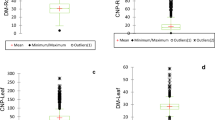Abstract
Cassava (Manihot esculenta) is a cyanide-containing food crop used by many indigenous peoples in Amazonia. Tukanoan Indians in Northwest Amazonia utilize both “bitter” and “sweet” cassava cultivars. Those classified as “bitter” are the dietary staple. Analysis of 13 commonly used “bitter” cultivars indicates that they are high in cyanide in comparison to values reportedin the literature. The Tukanoan practice of including the inner peel in the edible portion contributes to the high cyanide values found.
Résumé
Contenido de Cianuro en Variedades de Yuca Utilizada por los Tukanos en el Noroeste Amazónico. Las raíces de la yuca (Manihot esculenta,) constituyen un importante alimento energetico para grupos indígenas del Amazonas. Los Tukanos del noroeste Amazonico cultivan variedades “dulces” y “amargas” de yuca; las “amargas” proporcionan la mayoría de la energía en la dieta. El análisis de 13 de las más comunes variedades “amargas” por ellos utilizadas presenta valores altos de cianuro en comparación con aquellos previamente registrados en la literatura especializada. La inclusión de la corteza en la parte comestible se relaciona con los altos valores de cianuro encontrados.
Similar content being viewed by others
Literature Cited
Barrios, E. A., and R. Bressani. 1967. Composición química de la raiz y de la hoja de algunas variedades de yucaManihot. Turrialba 17(3):314–320.
Bolhuis, G. G. 1954. The toxicity of cassava roots. Netherlands J. Agric. Sci. 2(3):176–185.
Bourdoux, P., M. Mafuta, A. Hanson, and A. M. Ermans. 1980. Cassava toxicity: the role of linamarin. Pages 15–27in A. M. Ermans, N. M. Mbulamoko, F. Delange, and R. Ahluwalia, eds., Role of cassava in the etiology of endemic goitre and cretinism. IDRC-136e. International Development Research Centre, Ottawa, Canada.
—, P. Seghers, M. Mafuta, J. Vanderpas, M. Vanderpas-Rivera, F. Delange, and A. M. Ermans. 1982. Cassava products: HCN content and detoxification processes. Pages 51–58in F. Delange, F. B. Iteke, and A. M. Ermans, eds., Nutritional factors involved in the goitrogenic action of cassava. IDRC-184e. International Development Research Centre, Ottawa, Canada.
Cooke, R. D. 1978. An enzymatic assay for the total cyanide content of cassava (Manihot esculenta Crantz). J. Sci. Food Agric. 29:345–352.
—, and E. M. De La Cruz. 1982. The changes in cyanide content of cassava (Manihot esculenta Crantz) tissues during plant development. J. Sci. Food Agric. 33:269–275.
Coursey, D. G. 1973. Cassava as food: toxicity and technology. Pages 27–36in B. Nestel and R. Maclntyre, eds., Chronic cassava toxicity. IDRC-010e. International Development Research Centre, Ottawa, Canada.
De Bruijn, G. H. 1973. The cyanogenic character of cassava (Manihot esculenta). Pages 43–48in B. Nestel and R. Maclntyre, eds., Chronic cassava toxicity. IDRC-010e. International Development Research Centre, Ottawa, Canada.
Dufour, D. L. 1983. Nutrition in the Northwest Amazon: household dietary intake and time-energy expenditure. Pages 329–355in R. B. Hames and W. T. Vickers, eds., Adaptive responses of native Amazonians. Academic Press, New York.
—. 1985. Manioc as a dietary staple: implications for the budgeting of time and energy in the Northwest Amazon. Pages 1–20in D. J. Cattle and K. H. Schwerin, eds., Food energy in tropical ecosystems. Gordon and Breach, New York.
Fukuba, H., O. Igarashi, C. M. Briones, and E. M. T. Mendoza. 1984. Cyanogenic glucosides in cassava and cassava products: determination and detoxification. Pages 225–234in I. Uritani and E. D. Reyes, eds., Tropical root crops: postharvest physiology and processing. Tokyo: Japan Scientific Societies Press.
Gómez, G., D. de la Cuesta, M. Valdivieso, and K. Kawano. 1980. Total and free cyanide content of the parenchima and peel of roots of ten promising cassava genotypes. Turrialba 30(4):361–365.
Gómez, G., and M. Valdivieso. 1983. The effect of variety and plant age on cyanide content, chemical composition and quality of cassava roots. Nutr. Rep. Int. 27(4):857–865.
Joachim, A. W. R., and D. G. Pandittesekere. 1944. Investigations of the hydrocyanic acid content of manioc (Manihot utilissima). Trop. Agric. (Ceylon) 100:150–163.
Maduagwu, E. N., and A. F. Adewale. 1981. Loss of hydrocyanic acid and its derivatives during sun drying of cassava. Pages 149–151in E. R. Terry, K. A. Oduro, and F. Caveness, eds., Tropical root crops: research strategies for the 1980’s. IDRC-163e International Development Research Centre, Ottawa, Canada.
Ministry of Health, Mozambique. 1984. Mantakassa: an epidemic of spastic paraparesis associated with chronic cyanide intoxification in a cassava staple area of Mozambique. 2. Nutritional factors and hydrocyanic acid content of cassava products. Bull. World Health Organ. 62(3):485–492.
Nartey, F. 1978.Manihot esculenta (Cassava): cyanogenesis, ultrastructure and seed germination. Munksgaard, Copenhagen, Denmark.
Obigbesan, G. O., and M. Fafunso. 1980. Some chemical components of Nigerian cassava cultivars and of the processed product. Tropenlandwirt 81(2):151–161.
Osuntokun, B. O. 1981. Cassava diet, chronic cyanide intoxification and neuropathy in Nigerian Africans. World Rev. Nutr. and Dietetics 36:141–173.
Rajaguru, A. S. B. 1975. Problem of HCN in cassava. Univ. Sri Lanka Fac. Agric. Paper 75–7. Peradeniya, Sri Lanka.
Sinha, S. K., and T. V. R. Nair. 1968. Studies on the variability of cyanogenic glucoside content of cassava tubers. Indian J. Agric. Sci. 38:958–963.
Way, J. L. 1981. Pharmacologie aspects of cyanide and its antagonism. Pages 29–49in B. Vennesland, E. E. Conn, C. J. Knowles, J. Westley, and F. Wissing, eds., Cyanide in biology. Academic Press New York.
Wheatley, C. C. 1985. Storage of cassava roots for human consumption. Pages 673–684in J. H. Cock and J. A. Reyes, eds., Cassava: research, production and utilization. United Nations Development Program and Centro Internacional de Agricultura Tropical, Cali, Colombia.
Author information
Authors and Affiliations
Rights and permissions
About this article
Cite this article
Dufour, D.L. Cyanide content of cassava (Manihot esculenta, Euphorbiaceae) cultivars used by Tukanoan Indians in Northwest Amazonia. Econ Bot 42, 255–266 (1988). https://doi.org/10.1007/BF02858929
Received:
Accepted:
Issue Date:
DOI: https://doi.org/10.1007/BF02858929




